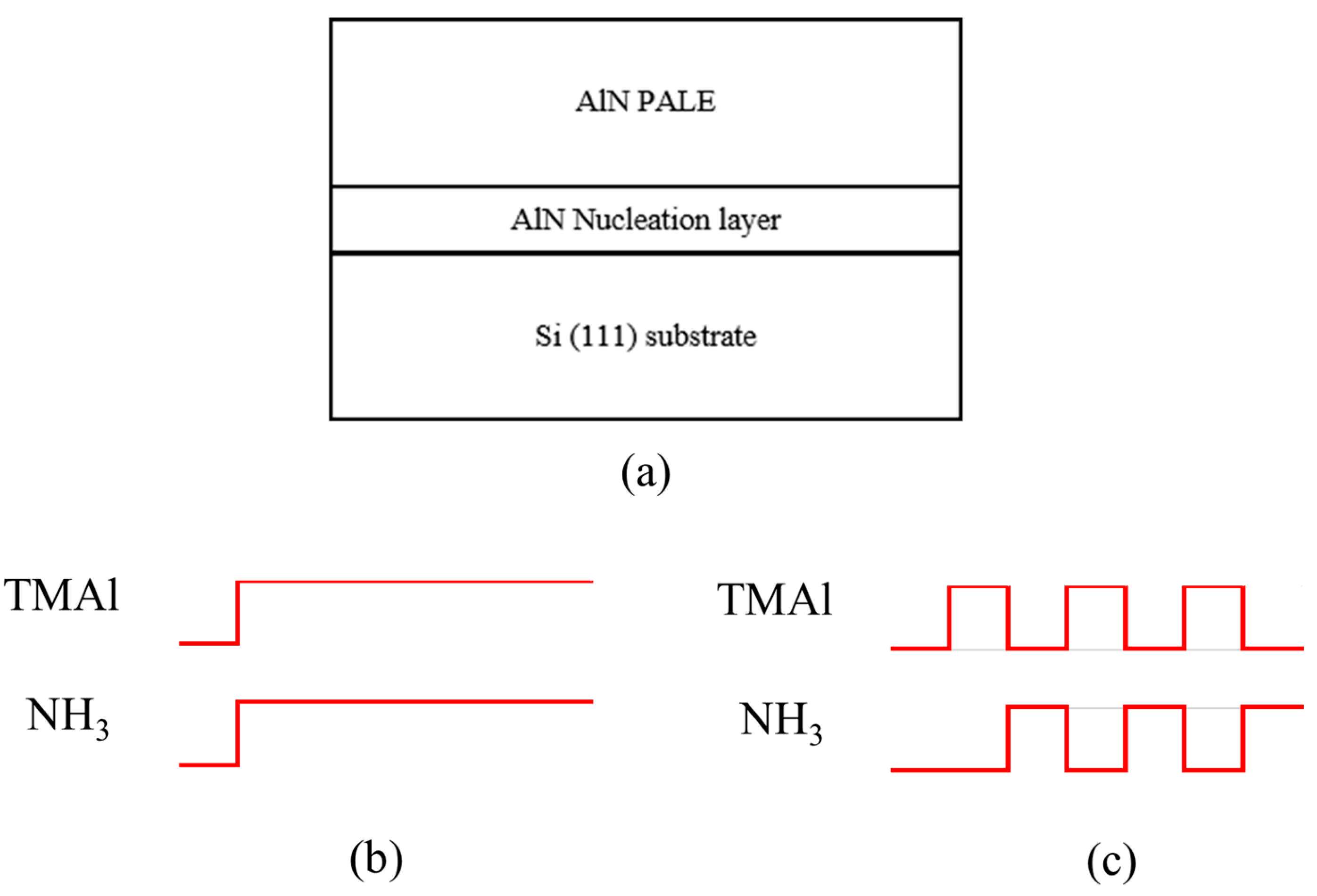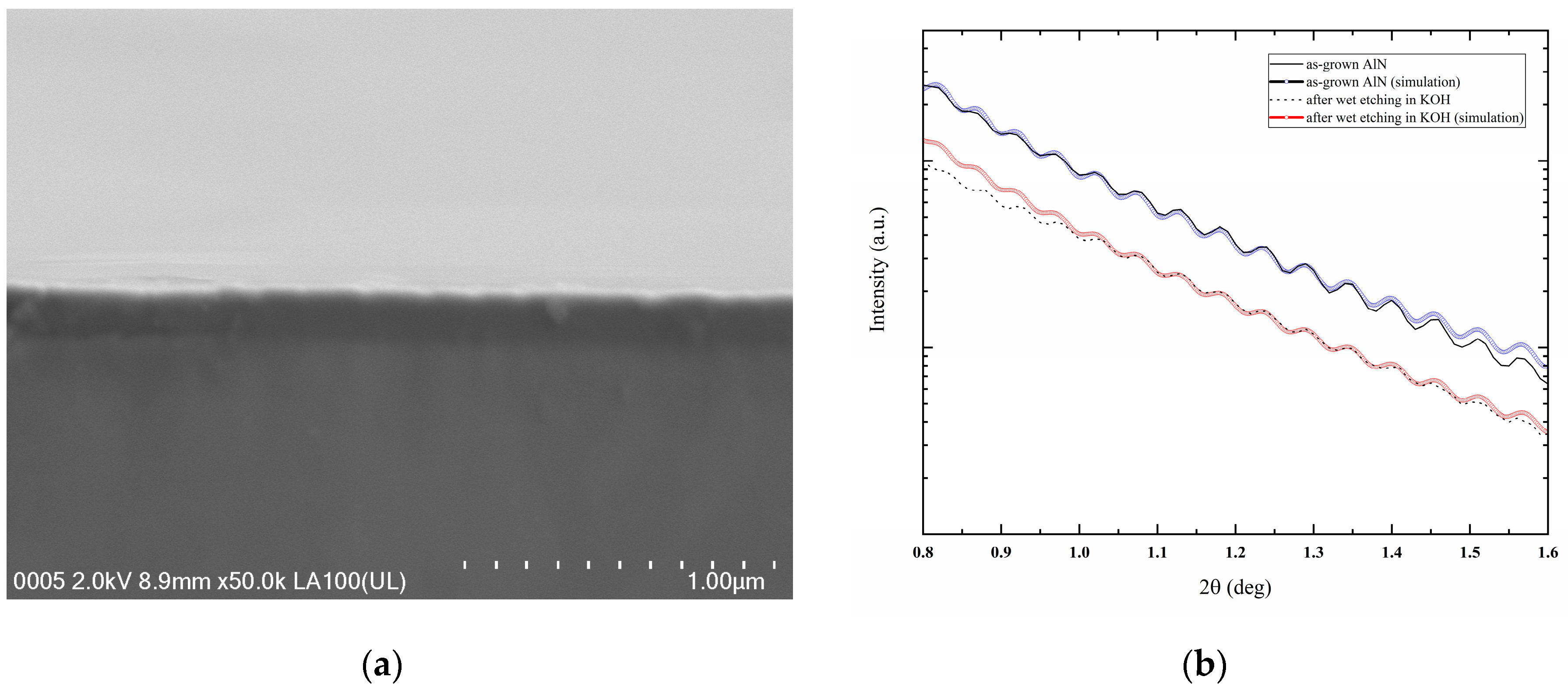Study of AlN Epitaxial Growth on Si (111) Substrate Using Pulsed Metal–Organic Chemical Vapour Deposition
Abstract
1. Introduction
2. Experimental Procedures
3. Results and Discussions
4. Conclusions
Author Contributions
Funding
Data Availability Statement
Acknowledgments
Conflicts of Interest
References
- Pengelly, R.S.; Wood, S.M.; Milligan, J.W.; Sheppard, S.T.; Pribble, W.L. A Review of GaN on SiC High Electron-Mobility Power Transistors and MMICs. IEEE Trans. Microw. Theory Tech. 2012, 60, 1764–1783. [Google Scholar] [CrossRef]
- Fletcher, A.S.A.; Nirmal, D. A Survey of Gallium Nitride HEMT for RF and High-Power Applications. Superlattices Microstruct. 2017, 109, 519–537. [Google Scholar] [CrossRef]
- Zhu, D.; Wallis, D.J.; Humphreys, C.J. Prospects of III-Nitride Optoelectronics Grown on Si. Rep. Prog. Phys. 2013, 76, 106501. [Google Scholar] [CrossRef] [PubMed]
- Nagamatsu, K.; Okada, N.; Sugimura, H.; Tsuzuki, H.; Mori, F.; Iida, K.; Bando, A.; Iwaya, M.; Kamiyama, S.; Amano, H.; et al. High-Efficiency AlGaN-Based UV Light-Emitting Diode on Laterally Overgrown AlN. J. Cryst. Growth 2008, 310, 2326–2329. [Google Scholar] [CrossRef]
- Inoue, Y.; Nagasawa, H.; Sone, N.; Ishino, K.; Ishida, A.; Fujiyasu, H.; Kim, J.J.; Makino, H.; Yao, T.; Sakakibara, S.; et al. Fabrication and Characterization of Short Period AlN/GaN Quantum Cascade Laser Structures. J. Cryst. Growth 2004, 265, 65–70. [Google Scholar] [CrossRef]
- Dadgar, A.; Poschenrieder, M.; Asing, J.B.; Contreras, O.; Bertram, F.; Riemann, T.; Reiher, A.; Kunze, M.; Daumiller, I.; Krtschil, A.; et al. MOVPE Growth of GaN on Si (111) Substrates. J. Cryst. Growth 2003, 248, 556–562. [Google Scholar] [CrossRef]
- Freedsman, J.J.; Watanabe, A.; Yamaoka, Y.; Kubo, T.; Egawa, T. Influence of AlN Nucleation Layer on Vertical Breakdown Characteristics for GaN-on-Si. Phys. Status Solidi A 2016, 213, 424–428. [Google Scholar] [CrossRef]
- Zhang, B.S.; Wu, M.; Shen, X.M.; Chen, J.; Zhu, J.J.; Liu, J.P.; Feng, G.; Zhao, D.G.; Wang, Y.T.; Yang, H. Influence of High-Temperature AIN Buffer Thickness on the Properties of GaN Grown on Si (111). J. Cryst. Growth 2003, 258, 34–40. [Google Scholar] [CrossRef]
- Kim, J.O.; Hong, S.K.; Lim, K.Y. Crack Formation in GaN on Si (111) Substrates Grown by MOCVD Using HT Al-preseeding and HT AlN Buffer Layers. Phys. Status Solidi C 2010, 7, 2052–2055. [Google Scholar] [CrossRef]
- Li, F.; Wang, L.; Yao, W.; Meng, Y.; Yang, S.; Wang, Z. Analysis of Growth Rate and Crystal Quality of AlN Epilayers by Flow-Modulated Metal Organic Chemical Vapor Deposition. Superlattices Microstruct. 2020, 137, 106336. [Google Scholar] [CrossRef]
- Huang, L.; Li, Y.; Wang, W.; Li, X.; Zheng, Y.; Wang, H.; Zhang, Z.; Li, G. Growth of High-Quality AlN Epitaxial Film by Optimizing the Si Substrate Surface. Appl. Surf. Sci. 2018, 435, 163–169. [Google Scholar] [CrossRef]
- Wang, D.; Uesugi, K.; Xiao, S.; Norimatsu, K.; Miyake, H. High-Quality AlN/Sapphire Templates Prepared by Thermal Cycle Annealing for High-Performance Ultraviolet Light-Emitting Diodes. Appl. Phys. Express 2021, 14, 035505. [Google Scholar] [CrossRef]
- Arulkumaran, S.; Egawa, T.; Matsui, S.; Ishikawa, H. Enhancement of Breakdown Voltage by AlN Buffer Layer Thickness in AlGaNGaN High-Electron-Mobility Transistors on 4 in. Diameter Silicon. Appl. Phys. Lett. 2005, 86, 123503. [Google Scholar] [CrossRef]
- Wang, H.; Li, S.L.; Xiong, H.; Wu, Z.H.; Dai, J.N.; Tian, Y.; Fang, Y.Y.; Chen, C.Q. The Effect of AlN Nucleation Temperature on the Growth of AlN Films via Metalorganic Chemical Vapor Deposition. J. Electron. Mater. 2012, 41, 466–470. [Google Scholar] [CrossRef]
- Feng, Y.; Wei, H.; Yang, S.; Chen, Z.; Wang, L.; Kong, S.; Zhao, G.; Liu, X. Competitive Growth Mechanisms of AlN on Si (111) by MOVPE. Sci. Rep. 2014, 4, 6416. [Google Scholar] [CrossRef] [PubMed]
- Hirayama, H.; Maeda, N.; Fujikawa, S.; Toyoda, S.; Kamata, N. Recent progress and future prospects of AlGaN-based high-efficiency deep-ultraviolet light-emitting diodes. Jpn. J. Appl. Phys. 2014, 53, 100209. [Google Scholar] [CrossRef]
- Zhang, J.P.; Asif Khan, M.; Sun, W.H.; Wang, H.M.; Chen, C.Q.; Fareed, Q.; Kuokstis, E.; Yang, J.W. Pulsed atomic layer epitaxy of ultrahigh-quality AlxGa1-xN structures for deep ultraviolet emissions below 230 nm. Appl. Phys. Lett. 2002, 81, 4392–4394. [Google Scholar] [CrossRef]
- Xue, J.; Zhang, J.; Hao, Y. Ultrathin barrier AlN/GaN high electron mobility transistors grown at a dramatically reduced growth temperature by pulsed metal organic chemical vapor deposition. Appl. Phys. Lett. 2015, 107, 043503. [Google Scholar] [CrossRef]
- Hirayama, H.; Yatabe, T.; Noguchi, N.; Ohashi, T.; Kamata, N. 231–261 nm AlGaN deep-ultraviolet light-emitting diodes fabricated on AlN multilayer buffers grown by ammonia pulsed-flow method on sapphire. Appl. Phys. Lett. 2007, 91, 071901. [Google Scholar] [CrossRef]
- Hirayama, H.; Fujikawa, S.; Noguchi, N.; Norimatsu, J.; Takano, T.; Tsubaki, K.; Kamata, N. 222–282 nm AlGaN and InAlGaN-based deep-UV LEDs fabricated on high quality AlN on sapphire. Phys. Status Solidi A 2009, 206, 1176–1182. [Google Scholar] [CrossRef]
- Abd Rahman, M.N.; Shuhaimi, A.; Abdul Khudus, M.I.M.; Anuar, A.; Zainorin, M.Z.; Talik, N.A.; Chanlek, N.; Abd Majid, W.H. Diminishing the Induced Strain and Oxygen Incorporation on Aluminium Nitride Films Deposited Using Pulsed Atomic-Layer Epitaxy Techniques at Standard Pressure MOCVD. J. Electron. Mater. 2021, 50, 2313–2322. [Google Scholar] [CrossRef]
- Abd Rahman, M.N.; Talik, N.A.; Abdul Khudus, M.I.M.; Sulaiman, A.F.; Allif, K.; Zahir, N.M.; Shuhaimi, A. Ammonia Flux Tailoring on the Quality of AlN Epilayers Grown by Pulsed Atomic-Layer Epitaxy Techniques on (0001)-Oriented Sapphire Substrates via MOCVD. CrystEngComm 2019, 21, 2009–2017. [Google Scholar] [CrossRef]
- Abd Rahman, M.N.; Yusuf, Y.; Anuar, A.; Mahat, M.R.; Chanlek, N.; Talik, N.A.; Abdul Khudus, M.I.M.; Zainal, N.; Abd Majid, W.H.; Shuhaimi, A. Agglomeration Enhancement of AlN Surface Diffusion Fluxes on a (0001)-Sapphire Substrate Grown by Pulsed Atomic-Layer Epitaxy Techniques: Via MOCVD. CrystEngComm 2020, 22, 3309–3321. [Google Scholar] [CrossRef]
- Rahman, M.N.A.; Sulaiman, A.F.; Khudus, M.I.M.A.; Allif, K.; Talik, N.A.; Basri, S.H.; Shuhaimi, A. Effects of Pulsed Cycle Number on the Quality of Pulsed Atomic-Layer Epitaxy AlN Films Grown via Metal Organic Chemical Vapor Deposition. Jpn. J. Appl. Phys. 2019, 58, SC1037. [Google Scholar] [CrossRef]
- Altuntas, I.; Kocak, M.N.; Yolcu, G.; Budak, H.F.; Kasapoğlu, A.E.; Horoz, S.; Gür, E.; Demir, I. Influence of the PALE Growth Temperature on Quality of MOVPE Grown AlN/Si (111). Mater. Sci Semicond. Process. 2021, 127, 105733. [Google Scholar] [CrossRef]
- Simsek, I.; Yolcu, G.; Koçak, M.N.; Pürlü, K.; Altuntas, I.; Demir, I. Nucleation Layer Temperature Effect on AlN Epitaxial Layers Grown by Metalorganic Vapour Phase Epitaxy. J. Electron. Mater. 2021, 32, 25507–25515. [Google Scholar] [CrossRef]
- Abd Rahman, M.N.; Shuhaimi, A.; Yusuf, Y.; Li, H.; Sulaiman, A.F.; Alif Samsudin, M.E.; Zainal, N.; Abdul Khudus, M.I.M. Standard Pressure Deposition of Crack-Free AlN Buffer Layer Grown on c-Plane Sapphire by PALE Technique via MOCVD. Superlattices Microstruct. 2018, 120, 319–326. [Google Scholar] [CrossRef]
- Zhang, H.; Persson, I.; Papamichail, A.; Chen Jr., T.; Persson, P.O.A.; Paskov, P.P.; Darakcieva, V. On the polarity determination and polarity inversion in nitrogen-polar group III-nitride layers grown on SiC. J. Appl. Phys. 2022, 131, 055701. [Google Scholar] [CrossRef]
- Arslan, E.; Ozturk, M.K.; Duygulu, Ö.; Kaya, A.A.; Ozcelik, S.; Ozbay, E. The influence of nitridation time on the structural properties of GaN grown on Si (111) substrate. Appl. Phys. A 2009, 94, 73–82. [Google Scholar] [CrossRef]
- Wang, W.; Yang, W.; Liu, Z.; Wang, H.; Wen, L.; Li, G. Interfacial Reaction Control and Its Mechanism of AlN Epitaxial Films Grown on Si (111) Substrates by Pulsed Laser Deposition. Sci. Rep. 2015, 5, 11480. [Google Scholar] [CrossRef]
- Li, Y.; Wang, W.; Li, X.; Huang, L.; Zheng, Y.; Chen, X.; Li, G. Nucleation Layer Design for Growth of a High-Quality AlN Epitaxial Film on a Si (111) Substrate. CrystEngComm 2018, 20, 1483–1490. [Google Scholar] [CrossRef]
- Masiello, F.; Cembali, G.; Chumakov, A.I.; Connel, S.H.; Ferrero, C.; Hartwig, J.; Sergeev, I.; Vaerenbergh, P.V. Rocking curve measurement revisited. J. Appl. Cryst. 2014, 47, 1304–1314. [Google Scholar] [CrossRef]
- Fan, R.; Zhi-Bao, H.; Jian-Nan, H.; Chen, Z.; Yi, L. Effects of AlN nucleation layer thickness on crystal quality of AlN grown by plasma-assisted molecular beam epitaxy. Chin. Phys. B 2010, 19, 116801. [Google Scholar]
- Lee, H.P.; Perozek, J.; Rosario, L.D.; Bayram, C. Investigation of AlGaN/GaN High Electron Mobility Transistor Structures on 200-Mm Silicon (111) Substrates Employing Different Buffer Layer Configurations. Sci. Rep. 2016, 6, 37588. [Google Scholar] [CrossRef] [PubMed]
- Feng, Y.; Saravade, V.; Chung, T.F.; Dong, Y.; Zhou, H.; Kucukgok, B.; Ferguson, I.T.; Lu, N. Strain-Stress Study of AlxGa1−xN/AlN Heterostructures on c-Plane Sapphire and Related Optical Properties. Sci. Rep. 2019, 9, 10172. [Google Scholar] [CrossRef] [PubMed]
- Wang, K.; Li, M.; Yang, Z.; Wu, J.; Yu, T. Stress Control and Dislocation Reduction in the Initial Growth of GaN on Si (111) Substrates by Using a Thin GaN Transition Layer. CrystEngComm 2019, 21, 4792–4797. [Google Scholar] [CrossRef]
- Pan, L.; Dong, X.; Li, Z.; Luo, W.; Ni, J. Influence of the AlN Nucleation Layer on the Properties of AlGaN/GaN Heterostructure on Si (1 1 1) Substrates. Appl. Surf. Sci. 2018, 447, 512–517. [Google Scholar] [CrossRef]







| No. | Title | Growth Technique | FWHM of AlN 0002 | References |
|---|---|---|---|---|
| 1. | This work | PMOCVD | 0.76° | |
| 2. | Influence of PALE growth temperature on quality of MOVPE grown AlN/Si (111) | PALE | 1.53° | [25] |
| 3. | Competitive growth mechanisms of AlN on Si (111) by MOVPE | Mass transport mechanism | 0.68° | [15] |
| PMOCVD Cycle Number | In-Plane Lattice Parameter | Out-of-Plane Lattice Parameter | ||||
|---|---|---|---|---|---|---|
| Qx/2π (nm−1) | a (Å) | Strain (%) | Qz/2π (nm−1) | c (Å) | Strain (%) | |
| 0 | 3.67 | 3.15 | 1.10 | 10.08 | 4.96 | −0.44 |
| 35 | 3.70 | 3.12 | 0.28 | 10.07 | 4.97 | −0.34 |
| 70 | 3.70 | 3.12 | 0.28 | 10.07 | 4.97 | −0.34 |
| 140 | 3.69 | 3.13 | 0.55 | 10.06 | 4.97 | −0.24 |
Disclaimer/Publisher’s Note: The statements, opinions and data contained in all publications are solely those of the individual author(s) and contributor(s) and not of MDPI and/or the editor(s). MDPI and/or the editor(s) disclaim responsibility for any injury to people or property resulting from any ideas, methods, instructions or products referred to in the content. |
© 2024 by the authors. Licensee MDPI, Basel, Switzerland. This article is an open access article distributed under the terms and conditions of the Creative Commons Attribution (CC BY) license (https://creativecommons.org/licenses/by/4.0/).
Share and Cite
Hisyam, M.I.; Shuhaimi, A.; Norhaniza, R.; Mansor, M.; Williams, A.; Mat Hussin, M.R. Study of AlN Epitaxial Growth on Si (111) Substrate Using Pulsed Metal–Organic Chemical Vapour Deposition. Crystals 2024, 14, 371. https://doi.org/10.3390/cryst14040371
Hisyam MI, Shuhaimi A, Norhaniza R, Mansor M, Williams A, Mat Hussin MR. Study of AlN Epitaxial Growth on Si (111) Substrate Using Pulsed Metal–Organic Chemical Vapour Deposition. Crystals. 2024; 14(4):371. https://doi.org/10.3390/cryst14040371
Chicago/Turabian StyleHisyam, Muhammad Iznul, Ahmad Shuhaimi, Rizuan Norhaniza, Marwan Mansor, Adam Williams, and Mohd Rofei Mat Hussin. 2024. "Study of AlN Epitaxial Growth on Si (111) Substrate Using Pulsed Metal–Organic Chemical Vapour Deposition" Crystals 14, no. 4: 371. https://doi.org/10.3390/cryst14040371
APA StyleHisyam, M. I., Shuhaimi, A., Norhaniza, R., Mansor, M., Williams, A., & Mat Hussin, M. R. (2024). Study of AlN Epitaxial Growth on Si (111) Substrate Using Pulsed Metal–Organic Chemical Vapour Deposition. Crystals, 14(4), 371. https://doi.org/10.3390/cryst14040371






